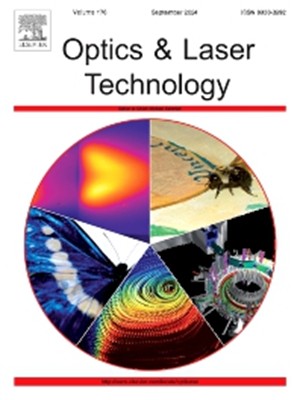Investigation on the effect of transverse phase error in tiled-array based coherent beam combining
IF 4.6
2区 物理与天体物理
Q1 OPTICS
引用次数: 0
Abstract
Coherent combining of an array of laser beams through a tiled aperture configuration is an effective method for scaling the far-field intensity. However, several parameters including the array fill factor, longitudinal as well as transverse phase errors, and mismatch in beam quality limit the maximum achievable beam combination efficiency in the far field. Optimizing such parameters and mitigating the effect of phase errors requires in-depth investigation of the tiled array beam combining system. We numerically analyze the performance of such a system in the presence of all the above errors using the band-limited angular spectrum method of field propagation, while employing the Stochastic Parallel Gradient Descent (SPGD) technique to synchronize the phase of the constituent elements. Based on simulations, we find that the fill factor of the array and the pointing error of the constituent beams are the major factors that degrade the beam combining efficiency and we quantify the degradation due to such factors. The simulation results are validated using a 7-channel tiled aperture beam combining experimental setup with a provision of tip-tilt adjustment for the individual beams.
求助全文
约1分钟内获得全文
求助全文
来源期刊
CiteScore
8.50
自引率
10.00%
发文量
1060
审稿时长
3.4 months
期刊介绍:
Optics & Laser Technology aims to provide a vehicle for the publication of a broad range of high quality research and review papers in those fields of scientific and engineering research appertaining to the development and application of the technology of optics and lasers. Papers describing original work in these areas are submitted to rigorous refereeing prior to acceptance for publication.
The scope of Optics & Laser Technology encompasses, but is not restricted to, the following areas:
•development in all types of lasers
•developments in optoelectronic devices and photonics
•developments in new photonics and optical concepts
•developments in conventional optics, optical instruments and components
•techniques of optical metrology, including interferometry and optical fibre sensors
•LIDAR and other non-contact optical measurement techniques, including optical methods in heat and fluid flow
•applications of lasers to materials processing, optical NDT display (including holography) and optical communication
•research and development in the field of laser safety including studies of hazards resulting from the applications of lasers (laser safety, hazards of laser fume)
•developments in optical computing and optical information processing
•developments in new optical materials
•developments in new optical characterization methods and techniques
•developments in quantum optics
•developments in light assisted micro and nanofabrication methods and techniques
•developments in nanophotonics and biophotonics
•developments in imaging processing and systems

 求助内容:
求助内容: 应助结果提醒方式:
应助结果提醒方式:


